What Happens Before, During, and After a Tornado?
tudents consider weather conditions before, during, and after a tornado and build a model of a vortex to visualize what is happening when a tornado occurs. Then they use an online simulator to explore the connection between tornado characteristics and tornado damage.
Learning Objectives
- Students engage in productive talk to formulate ideas about tornadoes
- Students use interactive reading strategies to gather evidence from text
- Students identify weather conditions before, during, and after a tornado
- Students use a model to understand tornadoes
- Students draw a diagram of their model and record observations
- Students make connections between tornado characteristics and resulting damage, using an online tornado simulator
Materials
- Image of a tornado (project or print out)
- Before/During/After a tornado images (in Explore section below)
- Tornadoes on the Soccer Field story
- Highlighters
- White board or chart paper & markers
- 8 oz. jar with lid (wide-mouthed jar is best)
- Water (to fill jar ⅔)
- 1 tsp white vinegar
- 1 tsp clear dish soap
- Glitter (to sprinkle in jar)
- Student laptops or tablets
- NOAA Tornado Simulator
Preparation
- Print copies of the Tornadoes on the Soccer Field story, one per student.
- Gather materials for the tornado model. If you are doing this activity with an entire class, prepare enough materials so that there is one Twister in a Jar per group of 2-3 students.
- Try out the NOAA Tornado Simulator before using with students.
Directions
Engage: The Explanation Game
- Show an image of a funnel cloud.
- Invite students to share observations about the image, using the following prompts: What do you see? What do you notice? What is happening?
- For each shared explanation, ask students to tell you specifically what evidence from the picture they are looking at (ex. I can see the debris cloud at the bottom of the twister picking up lots of dirt, so the winds must be very strong).
- Record students' responses in a list on the board or chart paper.
Explore: Before, During, and After a Tornado
- Pass out copies of the true story Tornadoes on the Soccer Field (one per student) and highlighter pens.
- Have students take turns reading the story aloud, one paragraph at a time.
- Pause after each paragraph and have students highlight any words or phrases in the story that give clues about the weather or describes the tornado. Model this by doing the first paragraph together.
- In the margin, have students note the words “before” “during” or “after” to indicate what they noticed happening at different stages of the tornado (focus on the change in weather before, during, and after a tornado).
- As a class, make a three-column chart of Before/During/After a tornado using the pictures of Before/During/After a tornado and student evidence they highlighted from the reading. Share that we are gathering evidence about what happens before, during, and after a tornado to try and understand what it is like to experience a tornado.
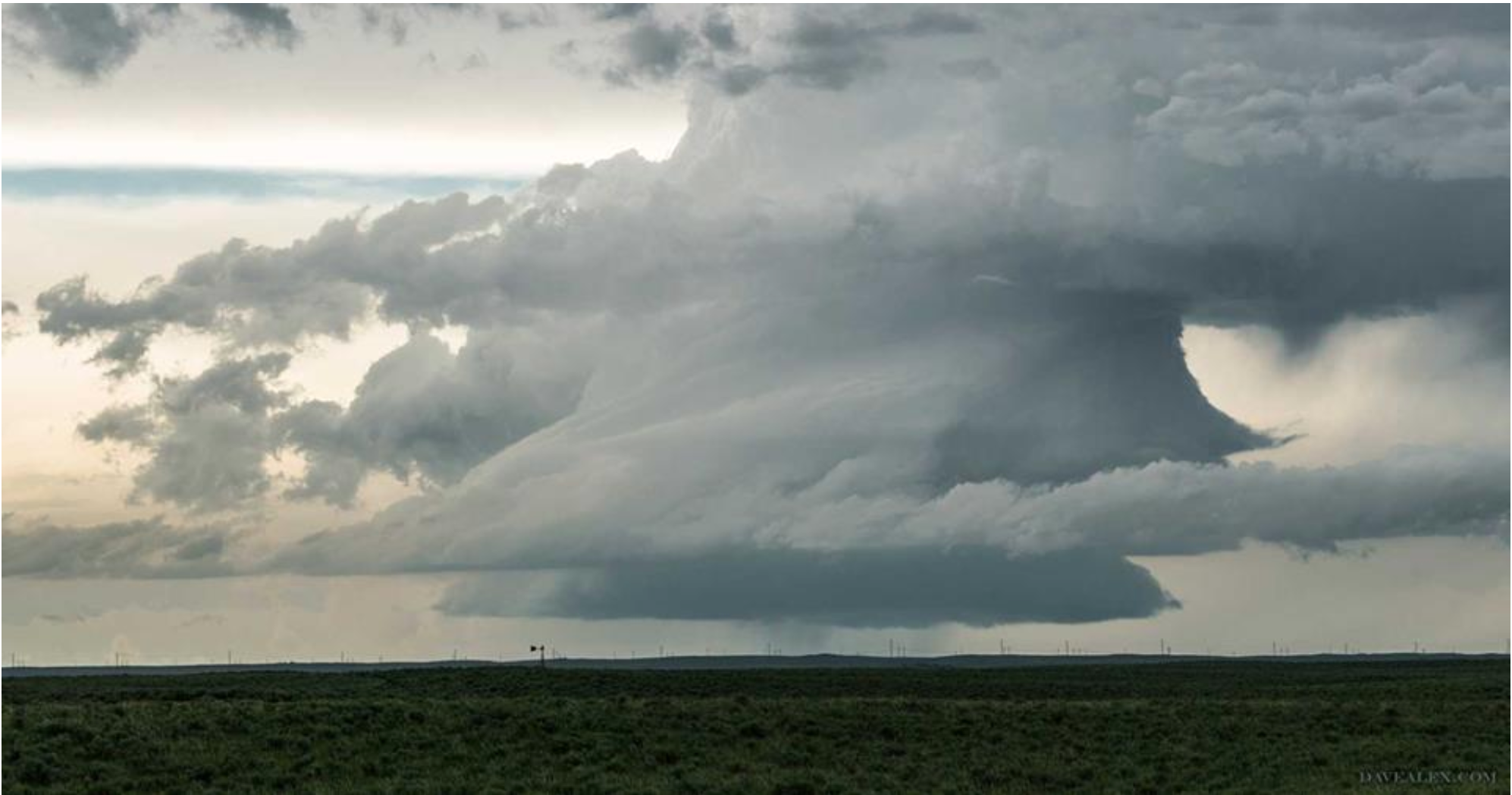
Before: Supercell formation, Keenesburg, CO, June 19, 2018. A supercell is a thunderstorm characterized by the presence of a mesocyclone: a deep, persistently rotating updraft.
Credit: Dave Alex
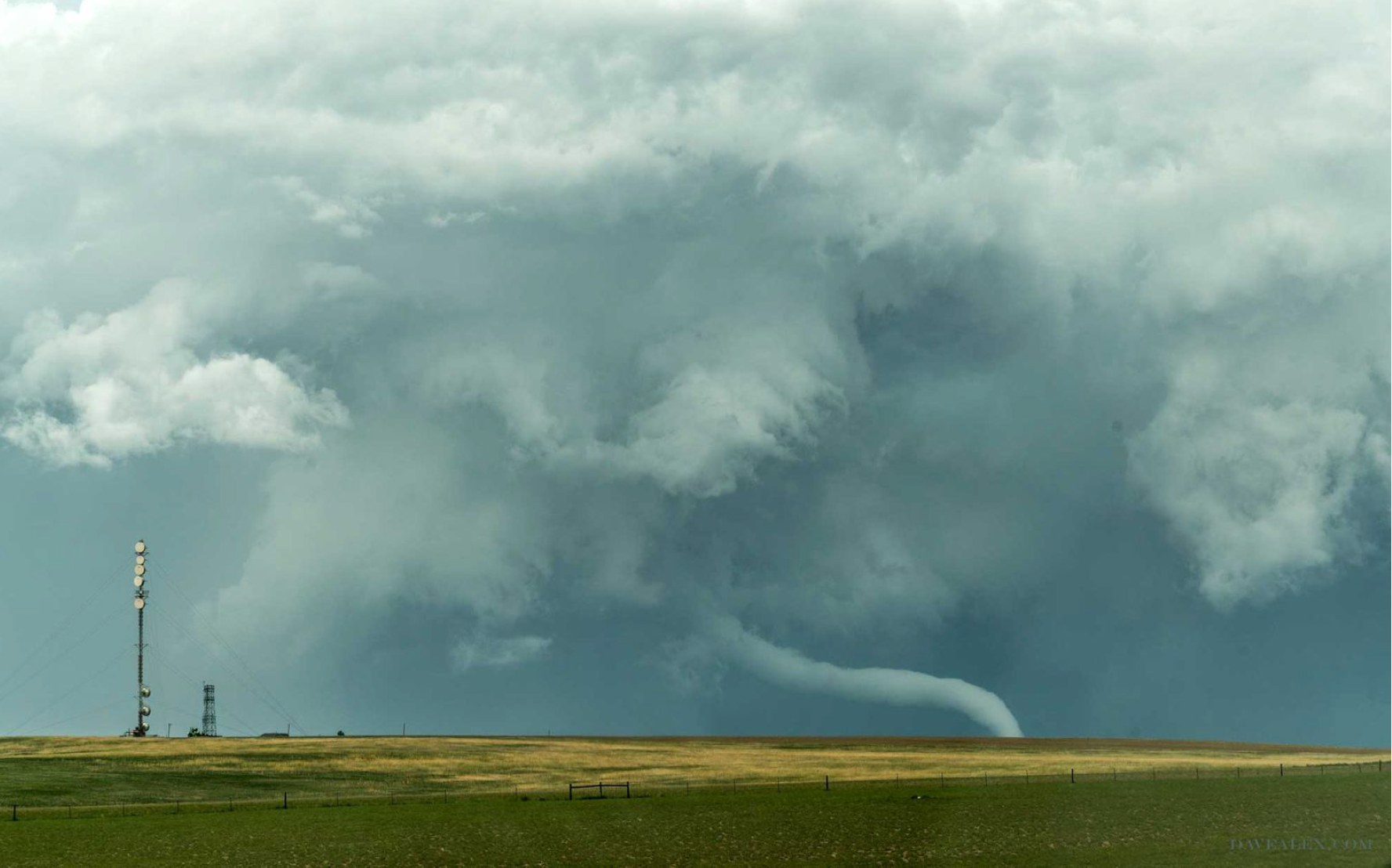
During: Tornado/funnel cloud, Keenesburg, CO, June 19, 2018. A funnel cloud is a funnel-shaped cloud of condensed water droplets, associated with a rotating column of wind and extending from the base of a cloud but not reaching the ground or a water surface. If a funnel cloud touches the ground it becomes a tornado.
Credit: Dave Alex
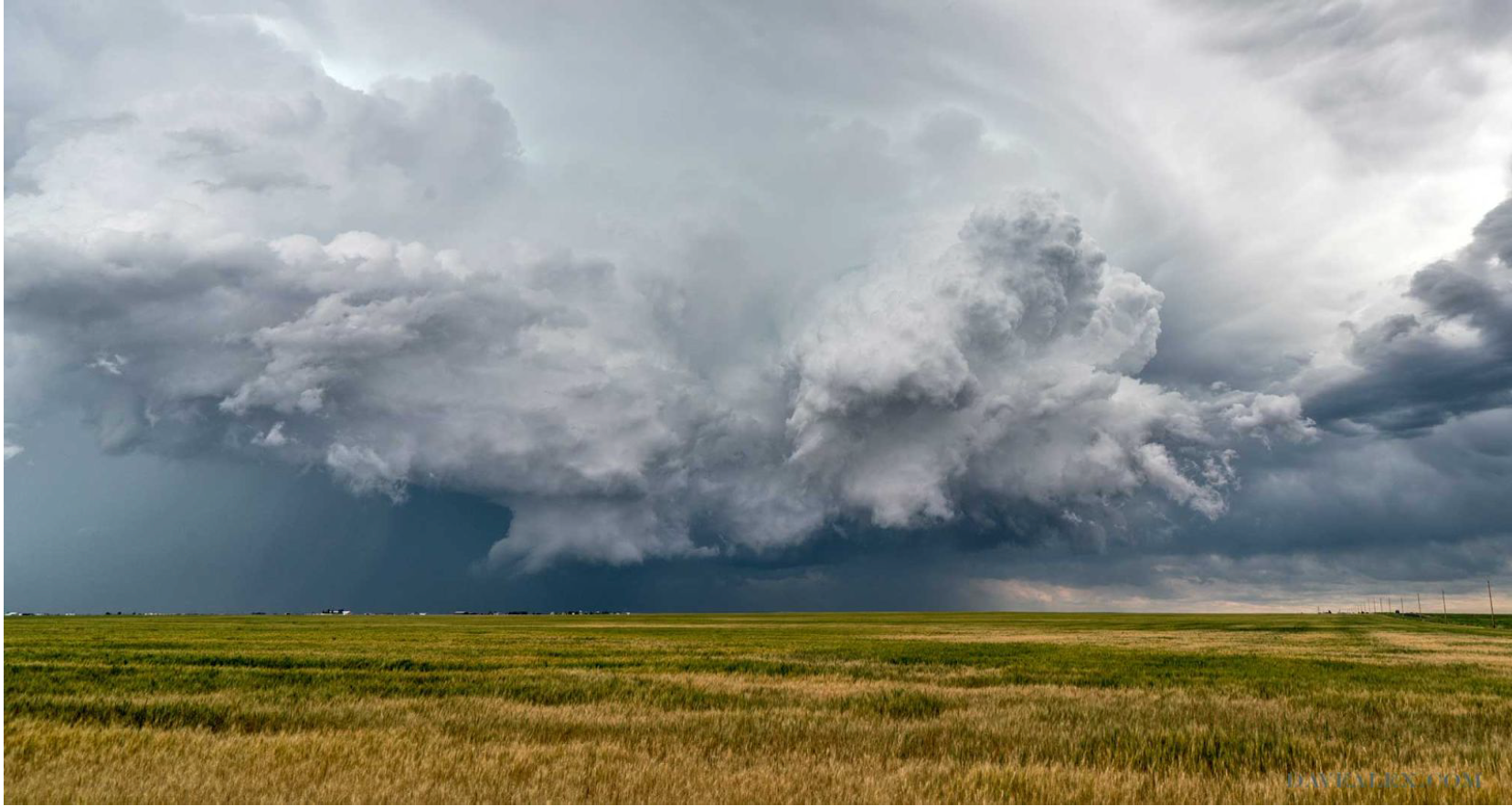
After: Break up of the supercell, Keenesburg, CO, June 19, 2018. The tornado is over and energy from the storm disperses.
Credit: Dave Alex
Explore: Make a Twister in a Jar
- Tell students that they will create a model to visualize what is happening during a tornado.
- Have students construct their model in small groups (2-3 students per group) using the following instructions:
- Fill the jar ¾ full of water.
- Add one teaspoon each of vinegar and dish soap.
- Sprinkle in a small amount of glitter into the jar.
- Close lid on jar tightly.
- Swirl the jar so that the liquids inside form a vortex.
- Stop swirling the jar and observe.
- Try it again! Take turns.
Explain: What can we learn from our model?
- Have students make observations of their model with their group. *Note: students should observe the glitter moving up and that their twister is larger at the top and narrower at the bottom. Students can:
- Draw a diagram of their twister, either one per group or individually in science notebooks.
- Label/draw arrows to show movement of water, glitter, etc.
- Write statements describing what they observed.
- Compare student models to evidence gathered in the “During” column of our chart (from the story and from the pictures).
- Compare student models to an actual tornado. How is our model similar to what happens in a real tornado? How is it different? What would our models need be more realistic?
Elaborate: A tornado simulation
- Use the NOAA Tornado Simulator to change aspects of the tornado and see what happens as a result. If students have access to laptops they can work individually or with a partner, or you can project the simulator and do this activity as a whole class.
- There are three aspects that can be observed with the simulator: the width of the tornado, and the pressure difference (between different air temperatures) and rotating speed of the wind. Note that pressure difference and rotating speed are linked together. These aspects determine the amount of damage a tornado can cause.
- Have students predict what might happen as you change each of these aspects. Ask them to explain their thinking: Why do you think that?
- Have students record in science notebooks what happens as they change the tornado aspects.
- Have students predict which conditions will cause the most damage. Test your predictions with the simulator!
- Relate the simulator to the Twister in a Jar model: how are the trees and house in the simulator like the glitter in your model?
Extensions
- Experiment with creating a model that more accurately represents an actual tornado; build on to what students have suggested as ways to improve their Twister in a Jar models.
- Study the Fujita Scale for measuring tornado damage and relate this scale to the tornado simulator activity.
- Learn about the National Weather Service tornado alerts and safety during a tornado.
- Write a fictional story/letter about experiencing a tornado.
Assessment
Have students revise their model drawings and answer the following questions:
- How could you make your twister in a jar model more like an actual tornado?
- Explain your twister in a jar model based on what you learned from the Tornado Simulator about funnel width and rotation speed.
Background
What's going on with the twister in a jar?
As you twist the jar, the water inside that is up against the glass is pulled along due to friction against the glass walls. The fluid toward the center of the jar takes longer to get moving, but eventually, all the fluid is spinning as you rotate the jar. When you stop rotating the jar, the fluid inside keeps spinning. A mini twister can be seen for just a few seconds when the outer fluid slows down and the inner fluid continues to spin rapidly.
How do tornadoes form?
Tornadoes are associated with large (supercell) thunderstorms. As part of the storm, warm and humid air rises. As it rises, it can start to rotate. How the column of air begins to rotate is not completely understood by scientists, but one way the rotation appears to happen is when winds at different altitudes blow at two different speeds.
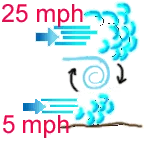
For example, a wind at 1000 feet above the surface might blow at 5mph and wind at 5000 feet might blow at 25 mph. Winds moving in different speeds and directions at different altitudes cause the rising air to start spinning.
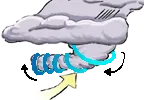
If the rotating column of air gets caught in an updraft (air flowing upward), the updraft tightens the spin and the rotation speeds up (much like a skater spins faster when arms are pulled close to the body). A funnel cloud is created.
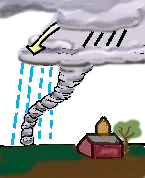
The rain and hail in the thunderstorm cause the funnel to touch down creating a tornado.
How does a thunderstorm form?
The action of warm air rising and cold air sinking (convection) plays a key role in the formation of severe thunderstorms. If the warm surface air is forced to rise, it will continue to rise, because it is less dense than the surrounding air. This is called an updraft.
What is a supercell thunderstorm?
- A supercell is a thunderstorm with a deep, rotating updraft. Not all thunderstorms are classified as supercells. The rotating updraft of a supercell is sometimes called a “mesocyclone”.
- Supercell thunderstorms occur when very strong updrafts are balanced by downdrafts, which can allow the storm to persist for many hours. In a supercell, moist, warm air may be forced to rise by an approaching cold front. The result is a strong, persistent updraft of warm moist air. Speeds in an updraft can be as fast as 90 miles per hour! The air cools as it rises. Water vapor condenses and forms cumulus clouds. When condensation occurs, heat (latent heat/energy ) is released and helps the thunderstorm grow.
- In the United States, supercells often form where warm, moist air from the Gulf of Mexico meets cool, dry air from over the North American continent.